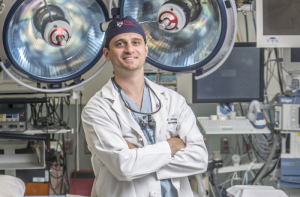Penn Medicine neurosurgeon performs first endoscopic spinal surgery in the state
by
Lauren Dubinsky, Senior Reporter | August 14, 2017

Dr. Neil R. Malhotra
A Penn Medicine neurosurgeon recently performed the first endoscopic spinal surgery in Pennsylvania on a patient with debilitating back and leg pain.
"I felt there was an opportunity to improve the patient experience by leveraging advanced technologies," Dr. Neil R. Malhotra, assistant professor of neurosurgery and orthopaedic surgery and the vice chairman of operations in the department of neurosurgery, told HCB News.
Each year, 200,000 Americans experience back pain, leg cramps and difficulty standing, bending or walking due to spinal nerve compression and stenosis, according to Penn.
Fifty-one year-old Kevin Clark suffered those symptoms for over a year, but has been pain-free for three months now. He underwent endoscopic percutaneous lumbar spinal nerve decompression and discectomy at the Hospital of the University of Pennsylvania in May.
Clark previously underwent open spinal laminectomy surgery three years ago for nerve compression that caused pain in his back and below his knees. He experienced a 100 percent improvement in symptoms, but the incision pain persisted for almost three months.
When he required treatment for his new problem above the knee, he chose to undergo the new minimally-invasive procedure in order to recover quicker. The same day as the procedure, he reported being able to walk around without pain and virtually no incision pain.
Malhotra stated that it's ideal for patients with symptoms in one leg that are caused by a disc herniation or a foramina stenosis. He added that 500,000 spinal decompression operations are performed each year in the U.S. and that at least a quarter would qualify for the minimally-invasive approach.
Although the endoscopic procedure has a 70 to 90 percent success rate and more invasive procedures have a 90 to 100 percent rate, its benefit is rapid recovery. Additionally, patients can opt for the more invasive surgery in the future if it's needed.
When developing this new surgical approach, Malhotra asked himself questions such as whether this will improve the chance for a cure and improve the patient's quality of life. then before implementing it at his hospital, he consulted with other thought leaders in the neurosurgery field to make sure every potential pitfall and challenge was thought through.
"In simple terms I basically say to myself, when comparing to the current technologies or approaches, 'is the new approach I am developing something I would want for my wife, or myself if needed'," he said. "If I can't surpass those hurdles in my mind, development stops."
He plans to work with colleagues to further develop the tool so that it can be used to remove spinal column and spinal cord tumors. He's hopeful that the procedure will be adapted for tumor removal within the next two to three years.
|
|
|
You Must Be Logged In To Post A Comment
|
